
The rocks of Mendip
Silurian | Devonian | Lower Carboniferous | Upper Carboniferous | Triassic | Lower to Middle Jurassic
Lower to Middle Jurassic rocks (200 to 161 million years ago)
The gradual flooding of the land by the sea at the end of the Triassic continued into the Early Jurassic, transforming the Mendips into islands. Near these ancient island shores the shell-rich limestone of the Doulting Stone and Chilcote Stone was formed, and in slightly deeper, quieter conditions, the thin, rhythmically alternating successions of limestone and mudstone, that are more typical of the Lias Group, were deposited. Fissures in the Carboniferous Limestone that had previously been infilled with Upper Triassic sediment were widened by extensional forces in the Early and Mid Jurassic, and further infilled by these younger sediments. Rises in sea level in the Mid Jurassic encroached on the Mendip islands and resulted in the cutting of a remarkable planar erosion surface across the Carboniferous Limestone. Above this surface the shallow-water limestones of the Inferior Oolite were intermittently deposited, capped by clay-rich sediments of the Fuller's Earth Formation.
Lias Group
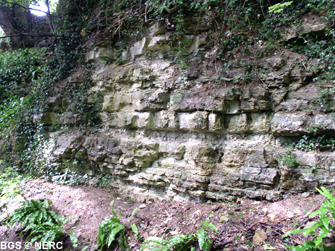
The Lias Group typically comprises a regularly alternating succession of thin, hard limestone and dark mudstone beds. The limestones usually weather out as resistant ribs, giving outcrops a very distinctive appearance. Some geologists believe that the alternating pattern of limestones and mudstones reflects regular climatic fluctuations at the time when the rocks were being formed. The whole succession is typically richly fossiliferous, particularly with ammonites and bivalves. These rocks are thought to have formed in open-water conditions, some distance from landmasses, and consequently are not well represented in the Mendip region which formed an island for most of the Early Jurassic. There is a thin representative of these rocks at Milton, near Wells, and good exposures near Shepton Mallet. The Charmouth Mudstone and Beacon Limestone formations form the youngest part of the Lias Group in the Mendip region, but substantial parts of this succession are missing, and the fossiliferous mudstones that form much of the remaining part of the succession are poorly exposed.
Downside Stone and Chilcote Stone
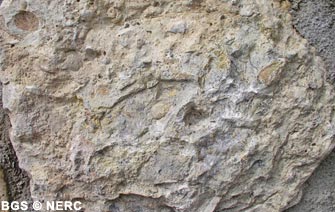
Between Shepton Mallet and Wells, the usual interbedded succession of mudstone and thin limestone that is so characteristic of the Lower Jurassic elsewhere in southern England, is replaced entirely by conglomeratic limestone. This rock formed near an ancient shoreline, the Mendips at this time forming part of a string of islands that extended westwards into South Wales. The limestone contains beds of broken and disarticulated thick-shelled bivalves, and bands of Carboniferous Limestone pebbles show that the emergent part of the Mendips was still being eroded. This rock was quarried at Downside and Chilcote for building stone.
Fissure-infilling rocks
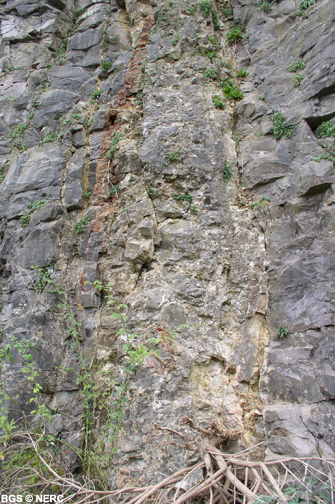
In the Late Triassic, deep fissures opened in the Carboniferous Limestone of the Mendips, possibly in response to tension in the Earth's crust associated with the opening of the Atlantic Ocean. Into these were swept sediments containing the remains of Late Triassic reptiles and primitive mammals. The fissures continued to develop in the Jurassic, when they were infilled with limestone and mudstone containing Jurassic fossils. These rocks once formed part of a normally bedded succession that covered parts of the Mendips as the sea slowly advanced over the surviving land areas in the Early Jurassic. Most of this succession was removed by later erosion, the only surviving remnants being those parts that collapsed into the underlying network of fissures.
Inferior Oolite Formation
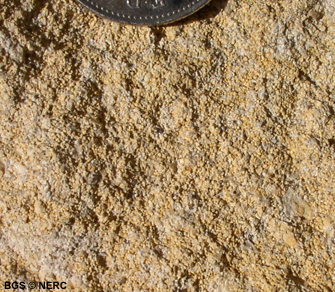
A few metres of yellow-weathering, fossiliferous limestone represents the Middle Jurassic Inferior Oolite. The limestone contains horizons of ooliths – small rounded grains with a concentrically layered cross-section – which grew by accretion of carbonate in shallow high-energy marine environments, and abraded crinoid ossicles derived from the Carboniferous Limestone. The rocks are richly fossiliferous with brachiopods, bivalves, ammonites and echinoids (sea urchins). The rock often shows evidence of frequent breaks between the accumulation of sediment, evidenced by eroded, bored or oyster-covered surfaces, rubbly, conglomeratic horizons, and abraded fossils coated with iron minerals and phosphate. At Doulting, part of the Inferior Oolite succession has been exploited as a building material since the Middle Ages, and is known as Doulting Stone.
Great Oolite Group (Fuller's Earth Formation and Frome Clay Formation)
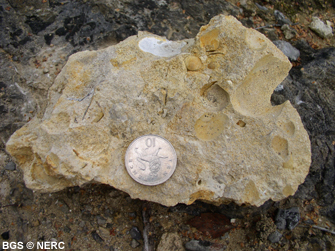
The youngest Jurassic rocks in the Mendips are represented by the Fuller's Earth and Frome Clay formations. These rocks cap ridges to the north and south of Mells and occur extensively around Frome, at the eastern margin of the region. At Doulting, near Shepton Mallet, the basal part of the Fuller's Earth is exposed, comprising 1.2 m of limestone overlain by 0.75 m of brown-yellow clay. The limestone is named the Fullonicus Limestone, after the characteristic abundance of the ammonite Procerites fullonicus. Pebbles of Inferior Oolite at the base of the Fullonicus Limestone indicate a period of erosion prior to deposition of the Great Oolite Group. The clays above the Fullonicus limestone contain abundant specimens of the small, ribbed oyster Catinula knorri, the source of the name 'Knorri Beds' for this part of the succession. The sudden change from the limestones of the Inferior Oolite to clay-rich rocks of the Great Oolite suggests a general deepening of the marine environment.
In the Bath area, thick oolite deposits were laid down, later quarried as 'Bath Stone'.
- Home
- Overview maps
- Locality
areas
- Cheddar Gorge
- Charterhouse
- Blackdown
- Burrington Combe
- Shipham & Rowberrow
- Crook Peak & Axbridge
- Banwell to Churchill
- Priddy
- Harptree & Smitham Hill
- Draycott & Westbury-sub-Mendip
- Wookey Hole & Ebbor Gorge
- Wells
- Great Elm & Vallis Vale
- Mells & the Wadbury Valley
- The Vobster area
- The Whatley area
- Torr Works & Asham Wood
- Beacon Hill
- Stoke St Michael & Oakhill
- Holwell & Nunney
- Shepton Mallet & Maesbury
- Gurney Slade & Emborough
- The Nettlebridge valley
- Geology
- Minerals and mines
- Quarrying
- Caves and karst
- Biodiversity
- Detailed site information
- Acknowledgements
- External links
- Search
- Site map